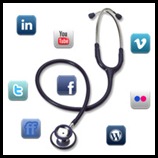 While medical marketing is something which needs to follow a lot of guidelines and regulations, health awareness and patient engagement are possible areas where social media can be employed. With exploding usage of social media, a time where your doctor’s twitter handle is part of your emergency kit is not far away.
While medical marketing is something which needs to follow a lot of guidelines and regulations, health awareness and patient engagement are possible areas where social media can be employed. With exploding usage of social media, a time where your doctor’s twitter handle is part of your emergency kit is not far away.
A real case in point being that of a simple tweet from a user suffering a heart attack that led to hundreds of tweeter responding to it and guiding him on how to stabilize himself before paramedics could reach him. With unlimited resource available on the internet, help can be only a tweet away.
While internationally lot of pharmaceutical companies along with prominent hospital chains have taken to social media, in India the scene is little different. Not many pharmaceutical companies have really taken the plunge. Although it must be said that the legal aspect of pharmaceutical marketing could be a barrier yet there is still a lot of scope for them to explore social media like their multinational counterparts.
On the other hand, for super specialty hospital chains armed with a marketing plan like any other FMCG company coming up in India, the scope of using social media platform is good. In fact, Apollo Hospitals already has a Facebook page with more than 58000 people while Max Healthcare Hospitals group has some 57000 people on its page.
The areas where social media can be majorly playing a part are:
-
Awareness
-
Fund raising
-
Helpline and assistance
Building Awareness
With more and more people logging on to the internet in search of authentic information, social networking platforms are fast becoming the research center for any subject. Keeping this in mind, hospitals across the world have realized the need of educating people about primary healthcare methods hoping that this would build a loyalty towards the institution if and when the need arises.
An example of this can be seen on Max Healthcare fan page that utilizes videos to provide information about healthcare to be taken during pregnancy during late 30s. Such critical information might not be available directly, hence, the it becomes critical for an authentic source like Max Healthcare to provide it.
Internationally Johnson & Johnson has a YouTube network channel JNJHealth with a video library of over 500 videos and over 6 million views. The channel is sub categorized in to various aspects that dwell on better understanding of health issues. With user based stories forming a major part of the library, the emotional connect that the channel brings in is incredible.
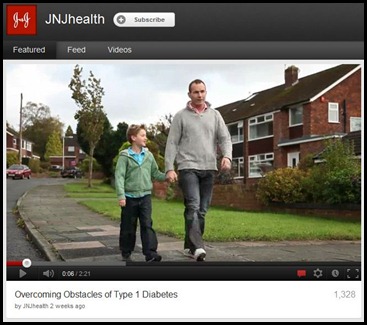
Johnson and Johnson Healthcare YouTube network
Another route explored internationally for building awareness is the live tweeting of surgeries from prominent hospitals. While this may sound very frivolous to general audience, it is amazingly high value information sharing that the medical students can look towards in order to understand complex procedures.
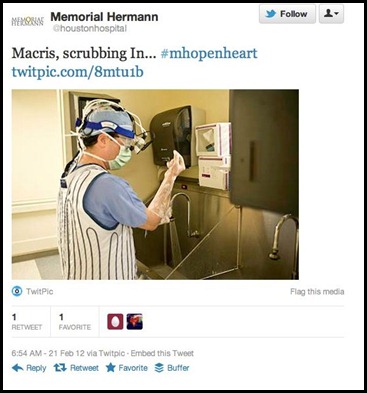
TwitPic shared during an open hearth surgery at Houston Hospital
Organizing Fund Raisers
Medical fund raisers are always an issue. While many would spend thousands on a trip, few would come out to provide to the local hospitals. This is a problem not just in our country, but across the globe. UCSF Benioff children’s hospital in San Francisco came up with an innovative plan to get the community support in fund raising.
In association with University of California, it ran an eight week fund raising campaign in association with www.causes.com and Facebook. Several Silicon Valley stalwarts along with celebrities like Ashton Kutcher and MC Hammer, who used their twitter network to spread the word, lent their support.
Teams were made of followers and supporters, put together by selected leaders who formed the groups through their personal networks and then competed against each other for the grand prize of getting to name a prominent section of the hospital.
The UCSF Benioff Children’s hospital had already amassed $375 million towards the estimated $600 million when last reported. It not only shows that people are willing to help when approached in correct manner but also that find raising need not always be a pleading process. All one needs is a creative plan that is well executed through proper channels.
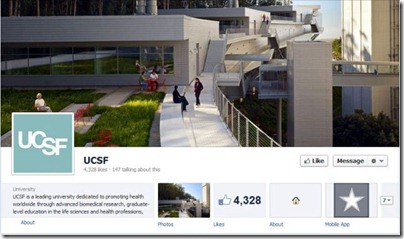
UCSF Facebook driving the fund raiser
Helping Handle
Like any other brand that has used twitter, hospitals and medical service providers are looking at using Twitter as a real time helpline that can address the patients’ emergency call. The idea can be extended in case of accidents where reaching doctors or hospitals would be difficult. In such case tweeting out for help and having a hospital respond to your call would act as a major assistance.
Although such a major helpline has yet not been setup, a rough estimate shows that already about 500 hospitals are on Twitter in United States of America alone. In India, major hospitals have setup their twitter accounts. With a little more planning and careful monitoring, a helpline setup can be easily put in place.
Getting healthy, socially
While another aspect that can be touched upon is the creation of online communities where people can come and share their experience, this is one area that many practitioners are not very keen on. The simple reason being that, while sharing your experience can give a lot of courage to someone going through the same illness, the conditions may be very different and hence the treatment plan. If not supervised properly this could well cause a complication. Although, if a monitoring and supervision module is put in place, this alone is one field that medical fraternity can look towards in order to raise awareness.
Social media is a way of life for most people in today’s date. It is not something that will fade away. If only, it will get more integrated in our lives and thus, leading to more and closer association to our everyday living. Thus, hospitals and medical institution should look at integrating this channel in their overall 360 degree marketing campaigns.
Comments
Tags: Awareness, Doctor, Fund Raising, Healthcare, Helpline, Hospitals, Social Media

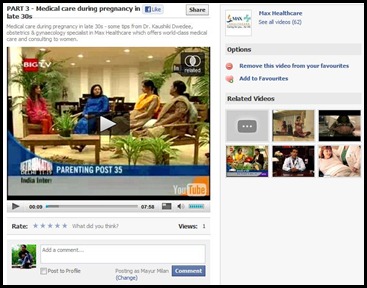
[…] You can also have a look at another blog ‘In the pink of Health on Social Media’. […]